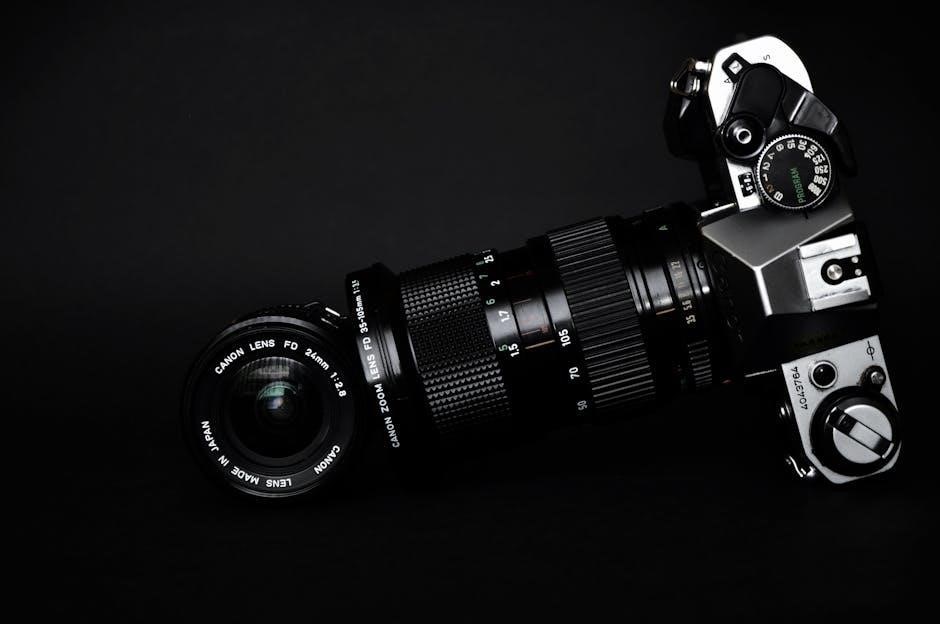The Husqvarna Z254 Service Manual PDF is a comprehensive guide essential for maintaining and repairing your zero-turn mower․ It includes detailed maintenance schedules, troubleshooting steps, and repair instructions․
Designed for both routine care and complex fixes, this manual ensures optimal performance and longevity․ Download the official PDF to access all features and prolong your mower’s lifespan․
1․1 Overview of the Husqvarna Z254 Service Manual
The Husqvarna Z254 Service Manual PDF is a detailed guide designed to help users maintain, troubleshoot, and repair their zero-turn mower․ It provides comprehensive information on routine maintenance, diagnostic steps, and repair procedures․ The manual includes detailed diagrams, specifications, and step-by-step instructions to ensure optimal performance and longevity․ Whether you’re a professional or a homeowner, this manual is an essential resource for keeping your Z254 in peak condition․
1․2 Purpose of the Service Manual
The purpose of the Husqvarna Z254 Service Manual is to provide users with detailed instructions for maintaining, troubleshooting, and repairing their zero-turn mower․ It serves as a comprehensive resource to ensure proper functionality, safety, and longevity of the equipment․ The manual covers routine maintenance tasks, diagnostic procedures, and repair guidelines, enabling users to address issues effectively and maintain optimal performance throughout the product’s lifespan․
1․3 Structure of the Service Manual
The Husqvarna Z254 Service Manual is organized into clear sections for easy navigation․ It begins with an introduction, followed by safety information, product specifications, and maintenance schedules․ The manual also includes troubleshooting guides, repair instructions, and additional resources like FAQs and online communities․ Each chapter focuses on specific aspects of the mower, ensuring users can quickly find the information they need to maintain, repair, or optimize their Z254 model effectively․
Safety Information
The Husqvarna Z254 Service Manual emphasizes safe operating practices, protective gear, and awareness of potential hazards․ Understanding safety symbols ensures proper usage and minimizes risks during maintenance and operation․
2․1 General Safety Guidelines
The Husqvarna Z254 Service Manual outlines essential safety guidelines to ensure safe operation and maintenance․ Always wear protective gear, including gloves, safety glasses, and sturdy footwear․ Keep loose clothing and long hair tied back to avoid entanglement․ Ensure the mower is on a level surface before operating or performing repairs․ Never allow children or unauthorized individuals near the machine while in use or during maintenance․ Adhering to these guidelines minimizes risks and prevents accidents․
Proper safety practices are crucial for the longevity of the equipment and the well-being of the operator․ Always follow recommended procedures and shutdown sequences to maintain control and stability․ Understanding and respecting safety protocols ensures a safer working environment and optimal machine performance․
2․2 Safety Precautions Before Performing Maintenance
Before performing any maintenance on the Husqvarna Z254, ensure the mower is turned off and the ignition switch is in the “OFF” position․ Disconnect the battery to prevent accidental startups․ Always engage the parking brake and use jack stands for added stability․ Wear protective gear, such as gloves and safety glasses, to safeguard against potential hazards․ Ensure the mower is on a level, stable surface before beginning work․ Never attempt repairs while the machine is in operation or under pressure․
Following these precautions ensures a safe working environment and prevents unforeseen accidents during maintenance tasks․
2․3 Understanding Safety Symbols and Decals
The Husqvarna Z254 service manual includes explanations of safety symbols and decals to ensure safe operation and maintenance․ These symbols provide critical warnings, cautions, and instructions to prevent accidents․ Familiarize yourself with each symbol to understand its meaning, as they are crucial for proper usage and upkeep․ Regularly inspect decals for clarity and integrity; worn or missing decals should be replaced to maintain safety standards and compliance with manufacturer guidelines․
Understanding these symbols is essential for safe and effective use of your mower․

Product Specifications and Features
The Husqvarna Z254 is a zero-turn mower with a robust engine, efficient transmission, and durable cutting deck․ Its advanced features ensure precise control and superior mowing performance․
3․1 Engine Specifications
The Husqvarna Z254 is equipped with a reliable Kohler® engine, delivering 24 HP and featuring a V-twin design for smooth operation․ The engine has a displacement of 726cc and operates at 3400 RPM․ It includes features like air cooling, overhead valves, and a spin-on oil filter for easy maintenance․ Regular oil changes and filter replacements are essential to ensure optimal performance and longevity, as outlined in the service manual․
3․2 Transmission and Drive System
The Husqvarna Z254 features a reliable hydrostatic transmission designed for smooth operation; The Hydro-Gear ZT-2200 system provides efficient power delivery and zero-turn capability․ This maintenance-free transmission eliminates the need for oil changes or level checks․ The mower’s drive system includes durable wheel motors, ensuring precise control and maneuverability․ Regular inspection of the transmission and drive components is recommended to maintain optimal performance and extend service life, as detailed in the service manual․
3․3 Cutting Deck and Blade Specifications
The Husqvarna Z254 is equipped with a 54-inch stamped steel cutting deck, designed for durability and precise cutting․ The deck features adjustable mowing height settings and anti-scalping wheels to protect turf․ High-lift blades ensure efficient grass discharge, especially when bagging․ Regular blade maintenance, including sharpening and inspection, is crucial for optimal performance․ The service manual provides detailed guidelines for deck adjustments and blade replacement to maintain cutting quality and extend equipment lifespan․
3․4 Control Panel and Instrument Cluster
The control panel on the Husqvarna Z254 is designed for easy operation, featuring an ignition switch, blade engagement switch, and seat adjustment lever․ The instrument cluster includes a service meter that tracks maintenance intervals․ These components ensure smooth functionality and user convenience․ The service manual provides detailed instructions for troubleshooting and maintaining these systems, ensuring optimal performance and user safety throughout the mower’s lifespan․ Regular checks are recommended to maintain reliability and functionality․

Maintenance Schedules
The Husqvarna Z254 service manual outlines essential routine and seasonal maintenance tasks․ Regular checks, oil changes, and blade inspections ensure optimal performance and extend the mower’s lifespan․ The service meter helps track maintenance intervals, making it easy to stay on schedule and maintain reliability throughout the year․
4․1 Routine Maintenance Tasks
Regular maintenance is crucial for the Husqvarna Z254’s performance․ Tasks include oil changes every 50 hours, blade inspections, and tire pressure checks․ Clean the mower deck and cooling vents frequently․ Sharpen blades monthly and replace worn parts․ Check the transmission fluid level and ensure proper lubrication of moving components․ Follow the service manual’s schedule to prevent wear and tear, ensuring reliable operation and extending the mower’s lifespan;
Adhering to these routines guarantees optimal functionality and safety․
4․2 Seasonal Maintenance Requirements
Seasonal maintenance ensures the Husqvarna Z254 operates efficiently year-round․ At the end of the mowing season, drain fuel, clean the mower deck, and apply rust protection․ Store the mower in a dry, protected area․ In spring, inspect belts, blades, and tires․ Check hydraulic fluid levels and ensure all systems function properly․ Follow the service manual’s seasonal checklist to prepare for the next mowing season․
Regular seasonal care enhances performance and longevity․

Troubleshooting Common Issues
The Husqvarna Z254 service manual provides detailed diagnostic steps for common problems․ Address engine issues, cutting deck malfunctions, and transmission problems with practical solutions and repair guidance․
Refer to the manual for step-by-step troubleshooting․
5․1 Identifying Common Problems
Identifying common problems with the Husqvarna Z254 is crucial for effective troubleshooting․ The service manual highlights frequent issues such as engine starting difficulties, cutting deck malfunctions, and transmission performance problems․ These issues often arise from worn parts, incorrect settings, or lack of maintenance․ The manual provides symptom-based diagnostic steps to help users pinpoint root causes․ Regular reference to the manual ensures accurate identification and timely resolution of these issues, preventing further damage․
By understanding these common problems, users can address them efficiently, maintaining their mower’s performance and longevity․
5․2 Diagnostic Steps and Solutions
The Husqvarna Z254 service manual provides a systematic approach to diagnosing and resolving issues․ Start by identifying symptoms, such as unusual noises or reduced performance․ Consult the manual’s troubleshooting section for specific guidance․ Perform visual inspections, check fluid levels, and test components like blades or spark plugs․ For transmission leaks or blade malfunctions, refer to step-by-step repair instructions․ Addressing problems early ensures optimal functionality and prevents further damage․ Always follow recommended solutions to maintain your mower’s efficiency and reliability․
Repair and Replacement Guidance
The Husqvarna Z254 service manual provides detailed repair guidance, including tools needed, step-by-step replacement instructions, and post-repair checks to ensure proper functionality and safety․
6․1 Tools and Equipment Needed for Repairs
The Husqvarna Z254 service manual outlines essential tools and equipment for repairs, including wrenches, screwdrivers, and multimeters․ Specialized tools like a torque wrench and pressure washer may also be required․ Proper storage and organization of these tools ensure efficient repair processes and prevent equipment damage․ Always refer to the manual for specific tool recommendations to avoid using incompatible equipment․
Regularly inspect tools for wear and tear to maintain precision and safety during repairs․
6․2 Step-by-Step Instructions for Parts Replacement
The Husqvarna Z254 service manual provides clear, step-by-step guidance for replacing parts like blades, belts, and engine components․ Detailed diagrams and instructions ensure accurate installation and alignment․ Always follow manufacturer specifications to maintain machine performance and safety․
Before starting, disconnect power sources and prepare the mower as outlined․ Use torque specifications and alignment guides to secure parts correctly․ This ensures proper functionality and prevents future issues․
Documenting each step helps track repairs and ensures compliance with maintenance schedules․
6․3 Post-Repair Checks and Tests
After completing repairs, perform a thorough inspection to ensure all components function correctly․ Test the engine, transmission, and blade system for smooth operation․ Check fluid levels and ensure there are no leaks․ Verify proper alignment and tension of belts and blades․ Conduct a test drive on a level surface to confirm stability and performance․ Document all post-repair checks to ensure reliability and maintain warranty compliance․

Downloading the Husqvarna Z254 Service Manual PDF
The Husqvarna Z254 Service Manual PDF is available for free download from official sources and online marketplaces․ It provides detailed maintenance guidance and troubleshooting steps for optimal performance․
7․1 Sources for the Official Service Manual
The official Husqvarna Z254 service manual PDF can be downloaded from Husqvarna’s official website or authorized dealers; Additionally, platforms like ManualsLib, ManualsOnline, and other reputable sources offer free access to the manual․ Ensure authenticity by verifying the source to avoid unauthorized or incomplete versions․ Downloading from trusted sites guarantees accurate and comprehensive guidance for maintenance and repairs․
7․2 Installation and Viewing Tips
Download the Husqvarna Z254 service manual PDF and save it to your device for easy access․ Use a reliable PDF viewer like Adobe Acrobat or similar software for optimal readability․ Ensure your device meets the system requirements for smooth viewing․ For convenience, organize the manual in a dedicated folder or bookmark it for quick reference․ Always verify the manual’s authenticity to ensure it is complete and accurate;

Accessories and Enhancements
Explore popular accessories like mulch kits, bagger attachments, and LED light kits to enhance your Husqvarna Z254’s functionality․ These additions improve performance and customization for optimal mowing experiences․
8․1 Popular Accessories for the Husqvarna Z254
Enhance your mowing experience with accessories like mulch kits, bagger attachments, and LED light kits․ These options improve efficiency and customization, ensuring your Z254 performs optimally․ Mulch kits help in fertilizing your lawn, while bagger attachments collect grass clippings neatly․ LED light kits provide better visibility for early morning or late evening mowing sessions, making your tasks easier and safer․ These additions are designed to maximize your mower’s potential and adapt to various lawn care needs․

Warranty and Support Information
Husqvarna offers comprehensive warranty coverage for the Z254, ensuring protection for parts and labor․ Contact Husqvarna support for assistance, and refer to the manual for warranty terms․
9․1 Warranty Terms and Conditions
The Husqvarna Z254 is backed by a comprehensive warranty covering parts and labor for a specified period․ Proper maintenance, as outlined in the service manual, is required to maintain warranty validity․ Registration with Husqvarna is often necessary to activate coverage․ Terms and conditions vary by region, so consult the official manual or contact a Husqvarna dealer for detailed warranty information specific to your Z254 model․
9․2 Contacting Husqvarna Support
For inquiries, parts, or service-related questions, contact Husqvarna support through their official website or local dealers․ Use the provided contact information in the manual or visit the Husqvarna website for assistance․ Ensure to have your product’s serial number ready for efficient support․ Proper documentation, like a maintained service journal, can also aid in resolving issues promptly and effectively․

Environmental Considerations
Proper disposal of waste materials and eco-friendly maintenance practices are emphasized in the manual․ Follow guidelines to minimize environmental impact and promote sustainability while using the Husqvarna Z254․
10․1 Proper Disposal of Waste Materials
The Husqvarna Z254 service manual emphasizes responsible disposal of waste materials, such as used oil, filters, and batteries․ Always use authorized recycling centers to minimize environmental impact․ Proper disposal ensures compliance with local regulations and helps maintain ecological balance․ Documenting waste disposal can also support machine resale value by demonstrating adherence to eco-friendly practices․ Consult local guidelines for specific instructions on handling hazardous materials safely and effectively․
10․2 Eco-Friendly Maintenance Practices
The Husqvarna Z254 service manual emphasizes eco-friendly maintenance practices to minimize environmental impact․ It suggests using biodegradable lubricants and reducing water use during cleaning․ Proper disposal of hazardous materials, such as oil and batteries, through authorized centers is crucial․ Regular upkeep ensures efficient operation, cutting emissions and energy use․ Following these guidelines protects the environment and preserves the mower’s performance and resale value effectively․

User Reviews and Feedback
Users praise the Husqvarna Z254 service manual for its clarity and comprehensiveness․ With an average rating of 9․3, it’s highly regarded for ease of use and detailed guidance, ensuring effective maintenance and repair․ Many appreciate the accessibility of free PDF downloads, making it a valuable resource for mower owners seeking reliable support․
11․1 Customer Experiences and Ratings
Customers highly praise the Husqvarna Z254 service manual, with an average rating of 9․3․ Many users find it comprehensive and well-structured, making maintenance and repairs straightforward․ The manual’s clarity and detailed instructions are frequently highlighted, ensuring users can troubleshoot and fix issues confidently․ Positive feedback also notes the ease of understanding, even for those less experienced with machinery․ Overall, it’s regarded as an indispensable resource for Z254 owners, enhancing their overall experience with the product․

Additional Resources
Explore FAQs, online forums, and official Husqvarna support for comprehensive assistance with the Z254 service manual and related queries․
12․1 Frequently Asked Questions (FAQs)
Common questions about the Husqvarna Z254 service manual include queries about maintenance schedules, troubleshooting, and parts replacement․ Users often ask where to download the PDF, how to access diagnostic steps, and tips for optimal mower performance․ FAQs also cover seasonal care, blade maintenance, and warranty information․ Refer to the manual for detailed answers and solutions to ensure proper operation and longevity of your Z254 mower․
12․2 Online Communities and Forums
Active online communities and forums offer valuable insights and support for Husqvarna Z254 users․ These platforms allow sharing of tips, troubleshooting advice, and real-world experiences․ Users can discuss maintenance, repairs, and upgrades, while also accessing free resources and guides․ Engaging with these communities helps optimize mower performance and resolve issues efficiently, fostering a collaborative environment for owners seeking assistance or sharing knowledge․
The Husqvarna Z254 Service Manual is crucial for maintaining your mower’s performance and longevity․ It provides essential guidance for safe operation, troubleshooting, and repairs․ Refer to it regularly to ensure optimal functionality and extend the lifespan of your equipment․ Proper use of this manual will help you maintain your Z254 effectively․
13․1 Final Thoughts on Using the Service Manual
Regularly referencing the Husqvarna Z254 Service Manual ensures your mower operates efficiently and safely․ By following the guidelines, you can prevent costly repairs and extend its lifespan․ Proper documentation in the Service Journal enhances resale value․ Always consult the manual for maintenance, troubleshooting, and repairs to maximize performance and maintain reliability․ It’s a vital resource for every Z254 owner․






































































